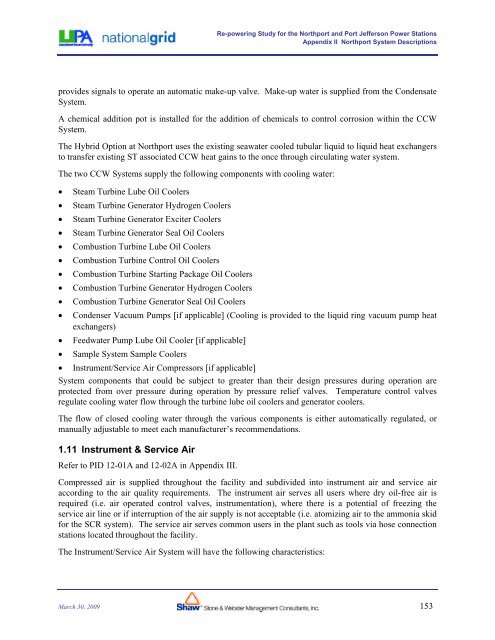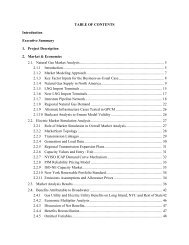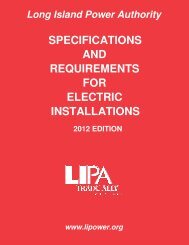Appendix E-2.c.i Energy Plan 2004-2013 Follow-up Studies and ...
Appendix E-2.c.i Energy Plan 2004-2013 Follow-up Studies and ...
Appendix E-2.c.i Energy Plan 2004-2013 Follow-up Studies and ...
Create successful ePaper yourself
Turn your PDF publications into a flip-book with our unique Google optimized e-Paper software.
Re-powering Study for the Northport <strong>and</strong> Port Jefferson Power Stations<br />
<strong>Appendix</strong> II Northport System Descriptions<br />
provides signals to operate an automatic make-<strong>up</strong> valve. Make-<strong>up</strong> water is s<strong>up</strong>plied from the Condensate<br />
System.<br />
A chemical addition pot is installed for the addition of chemicals to control corrosion within the CCW<br />
System.<br />
The Hybrid Option at Northport uses the existing seawater cooled tubular liquid to liquid heat exchangers<br />
to transfer existing ST associated CCW heat gains to the once through circulating water system.<br />
The two CCW Systems s<strong>up</strong>ply the following components with cooling water:<br />
• Steam Turbine Lube Oil Coolers<br />
• Steam Turbine Generator Hydrogen Coolers<br />
• Steam Turbine Generator Exciter Coolers<br />
• Steam Turbine Generator Seal Oil Coolers<br />
• Combustion Turbine Lube Oil Coolers<br />
• Combustion Turbine Control Oil Coolers<br />
• Combustion Turbine Starting Package Oil Coolers<br />
• Combustion Turbine Generator Hydrogen Coolers<br />
• Combustion Turbine Generator Seal Oil Coolers<br />
• Condenser Vacuum Pumps [if applicable] (Cooling is provided to the liquid ring vacuum pump heat<br />
exchangers)<br />
• Feedwater Pump Lube Oil Cooler [if applicable]<br />
• Sample System Sample Coolers<br />
• Instrument/Service Air Compressors [if applicable]<br />
System components that could be subject to greater than their design pressures during operation are<br />
protected from over pressure during operation by pressure relief valves. Temperature control valves<br />
regulate cooling water flow through the turbine lube oil coolers <strong>and</strong> generator coolers.<br />
The flow of closed cooling water through the various components is either automatically regulated, or<br />
manually adjustable to meet each manufacturer’s recommendations.<br />
1.11 Instrument & Service Air<br />
Refer to PID 12-01A <strong>and</strong> 12-02A in <strong>Appendix</strong> III.<br />
Compressed air is s<strong>up</strong>plied throughout the facility <strong>and</strong> subdivided into instrument air <strong>and</strong> service air<br />
according to the air quality requirements. The instrument air serves all users where dry oil-free air is<br />
required (i.e. air operated control valves, instrumentation), where there is a potential of freezing the<br />
service air line or if interr<strong>up</strong>tion of the air s<strong>up</strong>ply is not acceptable (i.e. atomizing air to the ammonia skid<br />
for the SCR system). The service air serves common users in the plant such as tools via hose connection<br />
stations located throughout the facility.<br />
The Instrument/Service Air System will have the following characteristics:<br />
March 30, 2009 153






